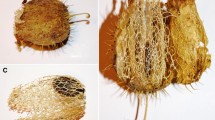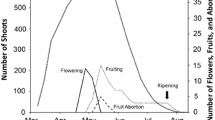Abstract
Oriental bittersweet (Celastrus orbiculatus Thunb.) is a non-indigenous, invasive woody vine in North America that proliferates in disturbed open sites. Unlike most invasive species, C. orbiculatus exhibits a ‘sit and wait’ strategy by establishing and persisting indefinitely in undisturbed, closed canopy forest and responding to canopy disturbance with rapid growth, often overtopping trees. We compared fruit fates of C. orbiculatus and native American holly (Ilex opaca). We also explored mechanisms for this ‘sit and wait’ invasion strategy by testing the effect of C. orbiculatus fruit crop density on removal rates and by examining the influence of seed treatment and light intensity on seed germination and seedling growth. More C. orbiculatus than I. opaca fruits became damaged, and damage occurred earlier. More fruit fell from C. orbiculatus than I. opaca, but removal rates by frugivores did not differ (76.0 ± 4.2% vs 87.5 ± 3.7%, respectively). Density (number of fruits in a patch) of C. orbiculatus did not influence removal rates. Scarification (bird-ingestion) of C. orbiculatus seed delayed germination but seeds germinated in similar proportion to manually defleshed seeds (sown either singly or all seeds from a fruit). Germination of seeds within intact fruits was inhibited and delayed compared to other treatments. Seed treatment did not affect seedling growth. The proportion of seeds germinating and time until germination was similar among five light intensity levels, ranging from full sun to closed-canopy. Seedlings in >70% photosynthetically active radiation (PAR) had more leaves, heavier shoots, and longer, heavier roots than seedlings at lower PAR levels. Results show that most (>75%) C. orbiculatus seeds are dispersed, seedlings can establish in dense shade, and plants grow rapidly when exposed to high light conditions. Control strategies for this highly invasive species should likely focus on minimizing seed dispersal by vertebrates.
Similar content being viewed by others
References
Barnea A,Yom-Tov Y andFriedman J (1990) Differential germination of two closely related species of Solanum in response to bird ingestion. Oikos 57: 222-228
Barnea A,Yom-Tov Y andFriedman J (1991) Does ingestion by birds affect seed germination? Functional Ecology 5: 394-402
Bazzaz FA (1986) Life history of colonizing plants: some demographic, genetic, and physiological features. In: Mooney HA andDrake JA (eds) Ecology of Biological Invasions of North America and HawaiI. Ecological Studies 58, pp 96-110. Springer-Verlag, New York
Clement CR,Warren RS,Dreyer GD andBarnes PT (1991) Photosynthesis, water relations and fecundity in the woody vines American and oriental bittersweet (Celastrus scandens and C. orbiculatus). American Journal of Botany 78(Suppl 6): 134-135
Davidar P andMorton ES (1986) The relationship between fruit crop sizes and fruit removal rates by birds. Ecology 67: 262-265
Denslow JS (1987) Fruit removal rates from aggregated and isolated bushes of red elderberry, Sambucus pubens. Canadian Journal of Botany 65: 1229-1235.
Drake JA,Mooney HA,Di Castri F,Groves RH,Kruger FJ,Rejmanek M andWilliamson M (eds) (1989) Biological Invasions: A Global Perspective. JohnWiley & Sons, Chichester, UK
Dreyer GD (1988) Efficacy of triclopyr in rootkilling Oriental bittersweet (Celastrus orbiculatus Thunb.) and certain other woody weeds. Proceedings of the Northeastern Weed Society 42: 120-121
Dreyer GD,Baird LM andFickler C (1987) Celastrus scandens and Celastrus orbiculatus: comparisons of reproductive potential between a native and an introduced woody vine. Bulletin of the Torrey Botanical Club 114: 260-264
Fox MD andFox BJ (1986) The susceptibility of natural communities to invasion. In: Groves RH andBurdon JJ (eds) Ecology of Biological Invasions, pp 57-66. Cambridge University Press, Cambridge
Fuentes M (1994) Diets of fruit-eating birds: what are the causes of interspecific differences. Oecologia 97: 134-142
Gordon DR (1998) Effects of invasive, non-indigenous plant species on ecosystem processes: lessons from Florida. Ecological Applications 8: 975-989
Hobbs RJ andAtkins L (1988) Effects of disturbance and nutrient addition on native and introduced annuals in plant communities in the western Australian wheatbelt. Australian Journal of Ecology 13: 171-179
Hobbs RJ andHuenneke LF (1992) Disturbance, diversity, and invasion: implications for conservation. Conservation Biology 6: 324-337
Howe HF (1986) Seed dispersal by fruit-eating birds and mammals. In: Murray D (ed) Seed Dispersal, pp 123-189. Academic Press, New York
Huenneke LF (1991) Population biology of an invading tree, Psidium cattleianum, in Hawaii Volcanoes National Park. In: Center TD,Doren RF,Hofstetter RL,Myers RL andWhitaker LD (eds) Proceedings of the Symposium on Exotic Pest Plants, pp 177-188. Technical Report NPS/NREVER/NRTR-91/06. US Department of the Interior National Park Service, Washington, DC
Hutchinson M (1992) Vegetation management guideline: Roundleaved bittersweet (Celastrus orbiculatus Thunb.). Natural Areas Journal 12: 161
Jung RE 1992. Individual variation in fruit choice by American Robins (Turdus migratorius). Auk 109: 98-111
McIntyre S andLavorel S (1994) Predicting richness of native, rare, and exotic plants in response to habitat and disturbance variables across a variegated landscape. Conservation Biology 8: 521-531
Levey DJ (1987) Facultative ripening in Hameia patens (Rubiaceae): effects of fruit removal and rotting. Oecologia 74: 203-208
Levey DJ,Moermond TC andDenslow JS (1984) Fruit choice in Neotropical birds: the effect of distance between fruits on preference patterns. Ecology 65: 844-850
Lodge DM (1993) Biological invasions: lessons for ecology. Trends in Evolution and Ecology 8: 133-137
McCarty JP, Levey DJ, Greenberg CH and Sargent S Spatial and temporal variation in fruit use by wildlife in a forested landscape. Forest Ecology and Management (in press)
McNab WH (1996) Classification of local-and landscape-scale ecological types in the southern Appalachian Mountains. Environmental Monitoring and Assessment 39: 215-229
McNab WH andMeeker M (1987) Oriental bittersweet: a growing threat to hardwood silviculture in the Appalachians. Northern Journal of Applied Forestry 4: 174-177
Moermond TC andDenslow JS (1985) Neotropical avian frugivores: patterns of behavior, morphology, and nutrition, with consequences for fruit selection. Ornithological Monographs 36: 865-897
Murray KG (1987) Selection for optimal fruit crop size in birddispersed plants. The American Naturalist 129: 18-31
Murray KG (1988) Avian seed dispersal of three neotropical gap dependent plants. Ecological Monographs 58: 271-298
Orians GH (1986) Site characteristics favoring invasions. In: Mooney HA andDrake JA (eds) Ecology of Biological Invasions of North America and Hawaii. Ecological Studies 58, pp 133-148. Springer-Verlag, New York
Patterson DT (1974) The ecology of oriental bittersweet, Celastrus orbiculatus, a weedy introduced ornamental vine. PhD dissertation, Duke University, Durham, North Carolina, 286 pp
Sargent S (1990) Neighborhood effects on fruit removal by birds: a field experiment with Viburnum dentatum (Caprifoliaceae). Ecology 71: 1289-1298
Stiles EW (1993) The influence of pulp lipids on fruit preference by birds. Vegetatio 108: 227-235
Traveset A (1998) Effect of seed passage through vertebrate frugivores' guts on germination: a review. Perspectives in Plant Ecology, Evolution and Systematics 1/2: 151-190
Usher MB (1988) Biological invasions of nature reserves: a search for generalizations. Biological Conservation 44: 119-135
USDA Forest Service (1948) Celastrus scandens L., American bittersweet. In: Woody Plant Seed Manual, pp 125-126. USDA Forest Service Northeastern Forest Experiment Station Miscellaneous Publication Number 654
Vitousek PM (1990) Biological invasions and ecosystem processes: toward an integration of population biology and ecosystem studies. Oikos 57: 7-13
Whelan CJ,Schmidt KA,Steele BB,Quinn WJ andDilger S (1998) Are bird-consumed fruits complementary resources? Oikos 83: 195-205
Willson MF (1994) Fruit choices by captive American Robins. Condor 96: 494-502
Willson MF andComet TA (1993) Food choices by Northwestern Crows: experiments with captive, free-ranging and hand-raised birds. Condor 95: 596-615
Willson MF andWhelan CJ (1993) Variation of dispersal phenology in a bird-dispersed shrub, Cornus drummondii. Ecological Monographs 63: 151-172
Witmer MC andVan Soest PJ (1998) Contrasting digestive strategies of fruit-eating birds. Functional Ecology 12: 728-741
Woodward FI (1993) How many species are required for a functional ecosystem? In: Schulze ED and Mooney HA (eds) Biodiversity and Ecosystem Function. Ecological Studies 99, pp 271-291. Springer-Verlag, New York
Author information
Authors and Affiliations
Corresponding author
Rights and permissions
About this article
Cite this article
Greenberg, C.H., Smith, L.M. & Levey, D.J. Fruit Fate, Seed Germination and Growth of an Invasive Vine – an Experimental Test of ‘sit and Wait’ Strategy. Biological Invasions 3, 363–372 (2001). https://doi.org/10.1023/A:1015857721486
Issue Date:
DOI: https://doi.org/10.1023/A:1015857721486




